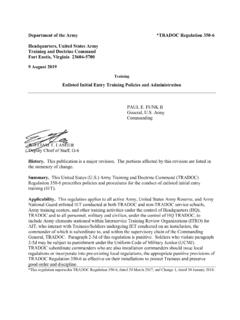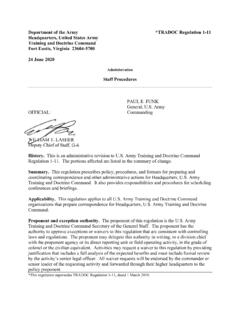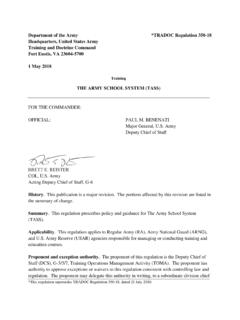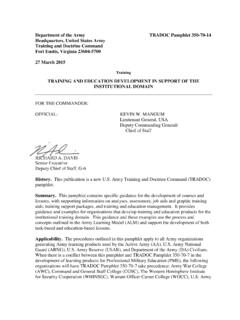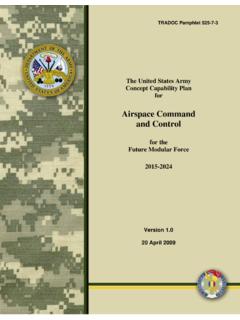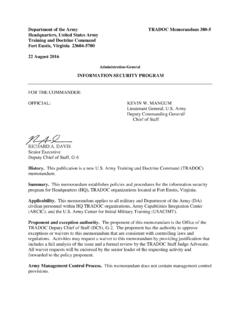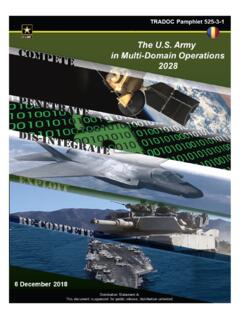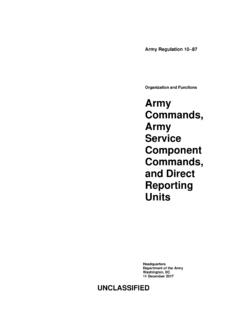Transcription of FOR THE COMMANDER - United States Army
1 Department of the army *TRADOC Pamphlet 350-70-1 Headquarters, United States army training and Doctrine Command Fort Eustis, Virginia 23604-5000 12 February 2019 training training Development in Support of the Operational training Domain FOR THE COMMANDER : OFFICIAL: THEODORE D. MARTIN Lieutenant General, army Deputy Commanding General/ Chief of Staff WILLIAM T. LASHER Deputy Chief of Staff, G-6 History. This publication is a major revision from the 24 February 2012 version. The summary of change lists the portions affected by this revision. Summary. This update provides guidance and examples for the development of unit training products. This pamphlet contains specific guidance for the development of combined arms training strategies (CATS), warfighter training support packages (WTSP), collective tasks, individual tasks, drills, and Soldier training Publications (STPs). Applicability. The procedures outlined in this pamphlet apply to all army organizations generating army learning products used by the Active army (AA), army National Guard (ARNG), and army Reserve (USAR).
2 Proponent and Exception Authority. The proponent for this pamphlet is the army Combined Arms Command (CAC), army University (ArmyU), Director, Learning Systems (DLS). The proponent has the authority to approve exceptions or waivers to this pamphlet that are consistent with controlling law and regulations. Suggested Improvements. Submit changes for improving this publication on Department of the army (DA) Form 2028 (Recommended Changes to Publications and Blank Forms) and send directly to the Provost, army University (ATTN: Director for Learning Systems (DLS), Policy *This pamphlet supersedes TRADOC Pamphlet 350-70-1, dated 24 February 2012. TRADOC Pamphlet 350-70-1 2 and Governance Division (PGD) (ATZL-AUL), Fort Leavenworth, KS 66027-2300 or electronically to Distribution. This pamphlet is available in electronic media only at the TRADOC Administrative Publications website ( ). Summary of Change TRADOC Pamphlet 350-70-1 training Development in Support of the Operational training Domain This major revision dated 12 February 2019- army mission Essential Task List Review Board and explains the role of its replacement by the Standards for training and Readiness Advisory Group and training development in support of the operational training domain.)
3 (chaps 1, 2, 5 and 9) and synchronizes content on mission analysis and needs analysis, and refines job analysis and personnel roles of the Critical Task Site Selection Board with corresponding content found in United States army training and Doctrine Command Pamphlet 350-70-14. (chap 2 and app F) c ombined arms training strategies development and standards. (chap 3) new numbering by echelon for collective tasks (changing from numbers to an abbreviation associated with a numerical identification code within collective tasks). (chap 5) and applies Field Manual 7-0 (Train to Win in a Complex World) doctrine. (chap 5) Live-Fire categories, statements and collective task linkages. (chap 5) Opposing Forces tasks and standards. (chap 5) military occupation specialty code structure to accommodate Warrant Officers and unique organizations. (chap 7) Soldier training Publications in coordination with Maneuver Center of Excellence. (chap 8) standard verb list for task titles from this pamphlet and places the list electronically on the training and Education Developers Toolbox.
4 (app E) all Building and Assessing training Readiness business rule requirements regarding training & Evaluation Outline development. (throughout) TRADOC Pamphlet 350-70-1 3 force generation terminology, processes and description. (throughout) training Development Capability as the Combined Arms Center approved automated development system to produce and revise army learning products. (throughout) and/or replaces outdated references. (throughout) TRADOC Pamphlet 350-70-1 4 This page intentionally left blank TRADOC Pamphlet 350-70-1 5 Contents Page Chapter 1 Introduction .. 9 1- 1. Purpose .. 9 1- 2. References .. 9 1- 3. Explanation of Abbreviations and Terms .. 9 1- 4. Scope .. 9 1- 5. Generating Force Support for Unit training .. 9 1- 6. Operational Domain training Products .. 11 1- 7. Integration of Generating Force Support and Operational training Products into training and 12 1- 8. army Learning Policy and Systems emphasis on Analysis, Design, Development, Implementation, and Evaluation (ADDIE).
5 13 Chapter 2 Generating Force Support and mission Analysis for Unit training Products .. 15 2- 1. Introduction .. 15 2- 2. mission Analysis for Unit training Products .. 18 2- 3. The mission Analysis Process .. 20 2- 4. Safety and Environment Responsibilities .. 26 2- 5. Unit Task List Approval .. 26 2- 6. mission Analysis Automation Support .. 27 2- 7. mission Analysis Quality Control (QC) .. 28 2- 8. mission Analysis Management .. 28 Chapter 3 The Combined Arms training Strategy (CATS) .. 28 3- 1. Introduction .. 28 3- 2. Overview .. 29 3- 3. CATS Types .. 30 3- 4. CATS Interface with army Processes and Models .. 30 3- 5. CATS Development .. 32 3- 6. CATS Management .. 51 Chapter 4 Warfighter training Support Packages (WTSP) .. 51 4- 1. Introduction .. 51 4- 2. Analysis for WTSPs .. 53 4- 3. Design the WTSP .. 54 4- 4. Develop the WTSP .. 56 4- 5. QC .. 56 Chapter 5 Collective Tasks .. 56 5- 1. Introduction .. 56 5- 2.
6 Analysis for Collective Tasks .. 58 5- 3. Design the Task Conditions .. 63 5- 4. Design the Task Standard .. 65 5- 5. Develop the Performance Steps and Performance Measures .. 71 5- 6. Identify the supporting Individual Tasks .. 75 5- 7. Identify the supporting Collective Tasks .. 76 5- 8. Identify the supporting Drills .. 77 5- 9. Safety and Environment Statements .. 77 5- 10. Opposing Forces (OPFOR) Tasks and Standards .. 77 5- 11. Equipment and Materiel .. 79 TRADOC Pamphlet 350-70-1 6 5- 12. training Aids, Devices, Simulators, and Simulations (TADSS) .. 79 5- 13. References .. 80 5- 14. Date/Time Stamp .. 80 5- 15. Unit Type and Echelon .. 80 5- 16. Remarks .. 80 5- 17. Task/Performance Evaluation Summary Block .. 80 5- 18. Synopsis Report .. 80 5- 19. training & Evaluation Outline .. 80 5- 20. Quality Control .. 80 Chapter 6 Drills .. 81 6- 1. Introduction .. 81 6- 2. Analysis for Drill Development .. 82 6- 3. Design the Drill.
7 83 6- 4. Develop the Drill Body .. 86 6- 5. Drill Synopsis Report .. 90 6- 6. Quality Control .. 90 Chapter 7 Individual Tasks .. 91 7- 1. Introduction .. 91 7- 2. Individual Task Analysis .. 93 7- 3. Design the Individual Task Condition .. 96 7- 4. Design the Individual Task Standard .. 97 7- 5. Develop Performance Steps .. 98 7- 6. Develop Performance Measures .. 100 7- 7. Identify Task Linkages .. 100 7- 8. Identify Military Occupational Specialty (MOS) and Skill Level .. 101 7- 9. Identify Skills and Knowledge .. 102 7- 10. Identify Evaluation Guidance .. 102 7- 11. Identify Evaluation Preparation .. 103 7- 12. Identify Equipment .. 103 7- 13. Safety and Environment Statements .. 103 7- 14. 104 7- 15. Synopsis Report .. 104 7- 16. Individual Task Report .. 104 7- 17. Quality Control .. 104 7- 18. Additional Information .. 104 Chapter 8 Soldier training Publications (STPs) .. 105 8- 1. Introduction .. 105 8- 2. Analysis for STPs.
8 107 8- 3. Design an STP .. 107 8- 4. Develop the STP .. 109 8- 5. Quality Control .. 111 Chapter 9 Managing Unit training Products .. 112 9- 1. Introduction .. 112 9- 2. Use of Collective Tasks .. 114 9- 3. Collective training Product Management .. 114 9- 4. Proponent Guidance for Individual Task Management .. 117 TRADOC Pamphlet 350-70-1 7 9- 5. Soldier training Publications .. 118 9- 6. Approval and Distribution of Unit training Products .. 120 9- 7. Validation .. 120 Appendix A References .. 121 Appendix B Unit training Material Examples .. 126 Appendix C Product Checklists .. 162 Appendix D Standard Verb Rules for Task Titles .. 181 Appendix E Critical Task And Site Selection Boards (CTSSB) .. 183 Glossary .. 186 Table List Table 5-1 Live-Fire statements .. 71 Table 6-1 Types of Drills .. 82 Table 7-1 Task types and descriptions .. 91 Table 8-1 STP types and descriptions .. 105 Table 8-2 Task summary format for an STP.
9 110 Table 9-1 STP staffing .. 119 Table B-3 WTSP elements .. 133 Table C-1 CATS QC checklist .. 163 Table C-2 WTSP 167 Table C-3 Collective task checklist .. 168 Table C-4 Drill Checklist .. 172 Table C-5 Individual task checklist .. 176 Table C-6 Individual critical task list (ICTL) checklist .. 179 Table C-7 STP checklist .. 180 Table D-1 Task title business rules .. 181 Table E-1 CTSSB members .. 183 Figure List Figure 1-1. ADDIE process with management components .. 13 Figure 2-1. Major elements of a unit task list .. 20 Figure 2-2. Sample type unit organization chart .. 25 Figure 3-1. Elements of a 33 Figure 3-2. The CATS task set elements .. 36 Figure 3-3. CATS task set numbering .. 37 Figure 3-4. CATS event elements .. 39 Figure 3-5. CATS execution guidance example .. 41 Figure 3-6. CATS task set example .. 43 Figure 3-7. Iteration example .. 45 Figure 3-8. Duration example .. 46 Figure 3-9. training audience example .. 47 Figure 3-10.
10 Example of resources allocated to a training event .. 49 Figure 3-11. CATS notional calendar example .. 51 Figure 4-1. WTSPs relationship to CATS events .. 52 Figure 4-2. WTSP numbering .. 54 TRADOC Pamphlet 350-70-1 8 Figure 5-1. New collective task creation guidelines .. 59 Figure 5-2. Collective task numbering format .. 61 Figure 5-3. Developing collective task titles .. 62 Figure 5-4. Writing collective task condition statements .. 63 Figure 5-5. Writing collective task standards .. 67 Figure 5-6. Task proficiency standards .. 68 Figure 5-7. Example objective task evaluation criteria matrix .. 69 Figure 5-8. Performance steps and performance measures .. 74 Figure 5-9. Collective task linkage .. 76 Figure 5-10. Environmental statement .. 77 Figure 5-11. OPFOR tasks and standards example .. 79 Figure 6-1. Drill ID number format .. 83 Figure 6-2. Considerations for writing drill conditions .. 84 Figure 6-3. Considerations for drill standard statements.

